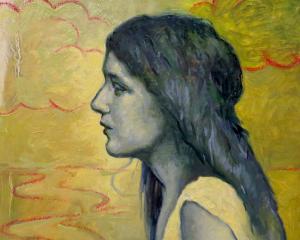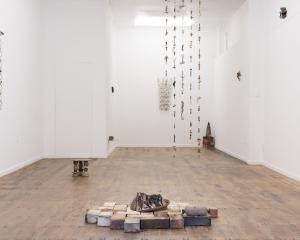Now she says she can't decide if she's a fine press printer or an artist who works with books, but doesn't see why she has to choose.
The Canberra artist is printer-in-residence at the bibliography room at the University of Otago Library this month. She has a compulsive love of books and text and loves the idea of working slowly and painstakingly to produce something lovely, she says as she works a 19th-century Columbian press with its iron eagle counterweight perched on top.
Her love of hand presses started when she was studying bibliography for a master's degree in English and her teacher took the class to the art school in Canberra to look at a letterpress so they could see how compositors made mistakes when setting type.
She demonstrates how a compositor would read a text and at the same time pick up the type letter by letter and put them, along with the spaces, in the composing stick upside down and back to front.
"Even when you are doing it millions of times, your brain is telling you one thing and your hands are doing another. It's like typing, really. It's just slow - it's like going slowly along a really straight road and still hitting a truck."
As soon as she finished her English degree, she went to art school to learn letterpress printing and hasn't really left since, she says with a laugh.
She teaches bookbinding and alternative book structures and book arts. She also produces her own work, has a studio with a Vandercook cylinder press, her own imprint, Ampersand Duck, and often works on collaborative projects with other artists.
In Dunedin she is enjoying the luxury of having only one thing to do for six weeks, and not juggling family, teaching and other jobs.
Here she is producing 100 copies of seven large poster poems by New Zealand and Australian poets, 2008 Burns Fellow Sue Wootton, 2009 Burns Fellow Michael Harlow, Vincent O'Sullivan, and Australian poets Sarah Holland-Batt, Les Murray, Robert Adamson and Stephen Edgar.
They will be printed on hand-made Italian Tiepolo paper and placed loose in a portfolio case so owners can frame them if they want. They will sell for $250.
While she loves working with old presses and hand-set type, Caren Florance also uses digital design tools. The internet and blogs have created a resurgence of interest in craft printing and linked collectors and customers with craft printers.
She has gathered a following and customers through her website, ampersandduck.com and her blog, ampersandduck.blogspot.com which features pictures and impressions of Dunedin in her recent entries.
However, she says, digital is more fragile and ephemeral than paper. She points out the Rosetta stone survived more than 2000 years and when found enabled scholars to translate Egyptian hieroglyphs, but she wonders if people will still be able to read DVDs in 100 or 200 years time.
"Everyone assumes we'll be able to read things retrospectively but there are only a few people keeping the old machines. Things get translated through digital generations only if they really need to be.
"It's like that old problem in medieval times of what got translated by the monks - only the things they thought were interesting, and so anything the Catholic Church didn't like got trashed and we lost lots of things," she said.
"Having said that, I don't actually make backups of my blog or website. I think of them as ephemeral as anything else. The National Library of Australia collects my blog in their Pandora web archive, and they sent me an email when they first started saying 'we guarantee you'll still be able to read this in 100 years time'. I get sceptical about that because I don't think they'll keep up the software or hardware."












